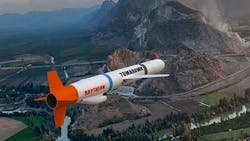Raytheon moves ahead with new guidance sensor and processor for anti-ship Tomahawk missile
PATUXENT RIVER NAS, Md. – Smart munitions experts at the Raytheon Co. are moving forward with a U.S. Navy program to retrofit the venerable Block IV Tactical Tomahawk missile for the anti-ship role with a new sensor system to enable the weapon to attack moving enemy vessels at sea.
Officials of the Naval Air Systems Command at Patuxent River Naval Air Station, Md., announced plans Thursday to award a contract to the Raytheon Missile Systems segment in Tucson, Ariz., to upgrade the Tactical Tomahawk guidance test set to support Maritime Strike Tomahawk (MST) integration and test efforts. The value of the upcoming contract has yet to be negotiated.
Raytheon will provide updated technical data package (TDP) upgrade test units to the Maritime Strike Tomahawk configuration. Raytheon will integrate seeker technology and processing capabilities into the Tactical Tomahawk Block IV missile to enable it to hit moving targets at sea.
The company will provide analysis, modeling, simulation, evaluation, prototyping, final integration, test, and delivery of a seeker and processor for the Tactical Tomahawk missile, and prepare for missile recertification. The Maritime Strike Tomahawk will enable Navy cruisers, destroyers, and attack submarines to attack maneuvering enemy vessels.
The Maritime Strike Tomahawk program slipped for seven months last year, and now its planned for initial operational capability in 2022, with procurement of upgrade kits continuing into 2023. Raytheon has been sole Tactical Tomahawk missile producer since 1994.
Raytheon's research on this program will involve architecture and algorithm development; prototyping; modeling and simulation test analysis; modernizing test equipment; hardware and software development; captive carry build-up and test; ground launch; and testing aboard surface warships.
Raytheon will provide 32 Maritime Strike Tomahawk upgrade kits in 2020; 50 kits in 2021, and 80 kits in 2022, at an estimated cost of about $457.9 million.
Navy joint task force commanders increasingly face long-range anti-ship missiles that threaten their surface forces and potentially deny access to mission-critical areas of operation, so they need a near-term capability to counter hostile surface forces. Without this, the Navy could face loss of life or critical mission failure, Navy officials say.
The Tactical Tomahawk missile alone has unique flight, launch, and information-processing capabilities that a seeker modification could help meet these needs affordably, officials say. Raytheon can integrate a new sensor suite into the Tactical Tomahawk quickly, and is the only known source with the technical knowledge to update the missile quickly enough for rapid delivery to the Fleet.
Since 2012 Raytheon has spent about $55 million of its own money for studies, mock-ups, and engineering analysis to find a Tomahawk missile seeker solution with the limited space available inside the missile to accommodate seekers, ancillary equipment and the processor.
For the Maritime Strike Tomahawk, Raytheon is proposing a seeker, processor, software, and a new inertial measuring unit for terminal maneuvers. Raytheon also is redesigning the system’s power budget and system cooling.
For more information contact Raytheon Missile Systems online at www.raytheon.com, or Naval Air Systems Command at www.navair.navy.mil.
Ready to make a purchase? Search the Military & Aerospace Electronics Buyer's Guide for companies, new products, press releases, and videos

